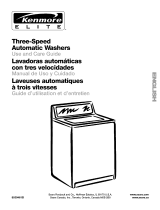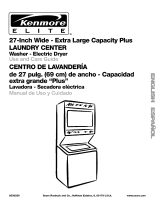13
TROUBLESHOOTING
First try the solutions suggested here and possibly avoid the cost of a service call...
Washer won't fill, rinse or wash
■Is the lid open?
The lid must be closed during operation. The washer will not
fill, agitate or spin with the lid open.
■Does the water level seem too low, or does the washer
appear to not fill completely?
The top of the agitator is much higher than the highest water
level. This creates a perception that the washer is not filling
completely. This is normal.
■Check the following:
Is the power cord plugged into a grounded 3 prong outlet?
Is there power at the plug? Check electrical source or call
electrician.
Are the hot and cold water faucets turned on?
Is the water inlet hose kinked?
Are the water inlet valve screens clogged?
Washer stops
■Check the following:
Is the power cord plugged into a grounded 3 prong outlet?
Are the hot and cold water faucets turned on?
Is the water inlet hose kinked?
Are the water inlet valve screens clogged?
■Is there power at the plug?
Check electrical source or call electrician.
■Has a fuse blown, or has the circuit breaker tripped?
If problem continues, call electrician.
■Are you using an extension cord?
Do not use an extension cord.
■Is the washer overloaded?
Wash smaller loads. See “Starting Your Washer” for maximum
load size.
■Is the lid open?
The lid must be closed during operation. The washer will not
fill, agitate or spin with the lid open.
Washer won't drain or spin
■Is the drain hose clogged, or the end of the drain hose
more than 72" (183 cm) above floor (48" [122 cm] for
portable washers)?
Refer to the installation instructions for your model for proper
installation of drain hose.
■Is the lid open?
The lid must be closed during operation. The washer will not
fill, agitate or spin with the lid open.
■Is there excessive sudsing?
Always measure detergent. Follow manufacturer's directions.
If you have very soft water, you may need to use less
detergent.
■Is your voltage low?
Check electrical source or call electrician. Do not use an
extension cord.
Washer continues to fill or drain, or the cycle seems
stuck
■Does the drain hose fit too tightly in the standpipe, or is it
taped to the standpipe?
The drain hose should be loose yet fit securely. Do not seal
the drain hose with tape. The hose needs an air gap. See
“Installation Instructions.”
■Is the end of the drain hose less than 39" (99 cm) above
the floor?
Refer to the installation instructions for your model for proper
installation of drain hose.
Washer makes noise
■Is the load balanced and the washer level?
The wash load should be balanced. See “Starting Your
Washer” for maximum load size.
The washer must be level. Refer to the installation
instructions for your model.
Can you hear water spraying? This is part of the wash action.
If water is drained quickly from the washer, you may hear air
being pulled through the pump. This happens during the end
of draining. It is normal.
When the cycle changes from washing to draining or
spinning, you may hear a noise as the drive system shifts.
This is normal.
■Are you washing items with metal snaps, buckles or
zippers?
You may hear metal items touching the basket. This is normal.
■Are you washing a small load?
You will hear more splashing sounds when washing small
loads. This is normal.
■Is the washer installed on a solid floor?
Refer to your installation instructions for flooring requirements.
Washer leaks
■Check the following:
Are the fill hoses tight? Are the fill hose washers properly
seated? Is the drain hose clamp properly installed? Refer to
the installation instructions for your model.
■Is the sink or drain clogged?
Sink, floor drain and standpipe must be able to handle
13 gal. (49.2 L) of water per minute.
■Is water bouncing off the tub ring or the load?
The wash load should be balanced and not overloaded. If not,
the fill or spray rinses can bounce off the load.
The washer must be level. Refer to the installation instructions
for your model.
■Did you install the drain hose in a standpipe or laundry
tub?
See “Installation Instructions.”
■Check household plumbing for leaks.





















